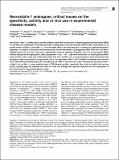| dc.contributor.author | Takahashi, N | |
| dc.contributor.author | Duprez, L | |
| dc.contributor.author | Grootjans, S | |
| dc.contributor.author | Cauwels, A | |
| dc.contributor.author | Nerinckx, W | |
| dc.contributor.author | DuHadaway, J B | |
| dc.contributor.author | Goossens, V | |
| dc.contributor.author | Roelandt, R | |
| dc.contributor.author | Van Hauwermeiren, F | |
| dc.contributor.author | Libert, C | |
| dc.contributor.author | Declercq, W | |
| dc.contributor.author | Callewaert, N | |
| dc.contributor.author | Prendergast, G C | |
| dc.contributor.author | Degterev, A | |
| dc.contributor.author | Yuan, Junying | |
| dc.contributor.author | Vandenabeele, P | |
| dc.date.accessioned | 2013-06-03T17:15:56Z | |
| dc.date.issued | 2012 | |
| dc.identifier.citation | Takahashi, N., L. Duprez, S. Grootjans, A. Cauwels, W. Nerinckx, J. B. DuHadaway, V. Goossens, et al. 2012. Necrostatin-1 analogues: critical issues on the specificity, activity and in vivo use in experimental disease models. Cell Death & Disease 3: e437. | en_US |
| dc.identifier.issn | 2041-4889 | en_US |
| dc.identifier.uri | http://nrs.harvard.edu/urn-3:HUL.InstRepos:10708066 | |
| dc.description.abstract | Necrostatin-1 (Nec-1) is widely used in disease models to examine the contribution of receptor-interacting protein kinase (RIPK) 1 in cell death and inflammation. We studied three Nec-1 analogs: Nec-1, the active inhibitor of RIPK1, Nec-1 inactive (Nec-1i), its inactive variant, and Nec-1 stable (Nec-1s), its more stable variant. We report that Nec-1 is identical to methyl-thiohydantoin-tryptophan, an inhibitor of the potent immunomodulatory enzyme indoleamine 2,3-dioxygenase (IDO). Both Nec-1 and Nec-1i inhibited human IDO, but Nec-1s did not, as predicted by molecular modeling. Therefore, Nec-1s is a more specific RIPK1 inhibitor lacking the IDO-targeting effect. Next, although Nec-1i was ∼100 × less effective than Nec-1 in inhibiting human RIPK1 kinase activity in vitro, it was only 10 times less potent than Nec-1 and Nec-1s in a mouse necroptosis assay and became even equipotent at high concentrations. Along the same line, in vivo, high doses of Nec-1, Nec-1i and Nec-1s prevented tumor necrosis factor (TNF)-induced mortality equally well, excluding the use of Nec-1i as an inactive control. Paradoxically, low doses of Nec-1 or Nec-1i, but not Nec -1s, even sensitized mice to TNF-induced mortality. Importantly, Nec-1s did not exhibit this low dose toxicity, stressing again the preferred use of Nec-1s in vivo. Our findings have important implications for the interpretation of Nec-1-based data in experimental disease models. | en_US |
| dc.language.iso | en_US | en_US |
| dc.publisher | Nature Publishing Group | en_US |
| dc.relation.isversionof | doi:10.1038/cddis.2012.176 | en_US |
| dc.relation.hasversion | http://www.ncbi.nlm.nih.gov/pmc/articles/PMC3542611/pdf/ | en_US |
| dash.license | LAA | |
| dc.subject | necroptosis | en_US |
| dc.subject | RIPK1 | en_US |
| dc.subject | IDO | en_US |
| dc.subject | necrostatin | en_US |
| dc.subject | SIRS | en_US |
| dc.subject | sepsis | en_US |
| dc.title | Necrostatin-1 Analogues: Critical Issues on the Specificity, Activity and In Vivo Use in Experimental Disease Models | en_US |
| dc.type | Journal Article | en_US |
| dc.description.version | Version of Record | en_US |
| dc.relation.journal | Cell Death & Disease | en_US |
| dash.depositing.author | Yuan, Junying | |
| dc.date.available | 2013-06-03T17:15:56Z | |
| dc.identifier.doi | 10.1038/cddis.2012.176 | * |
| dash.authorsordered | false | |
| dash.contributor.affiliated | Yuan, Junying | |


